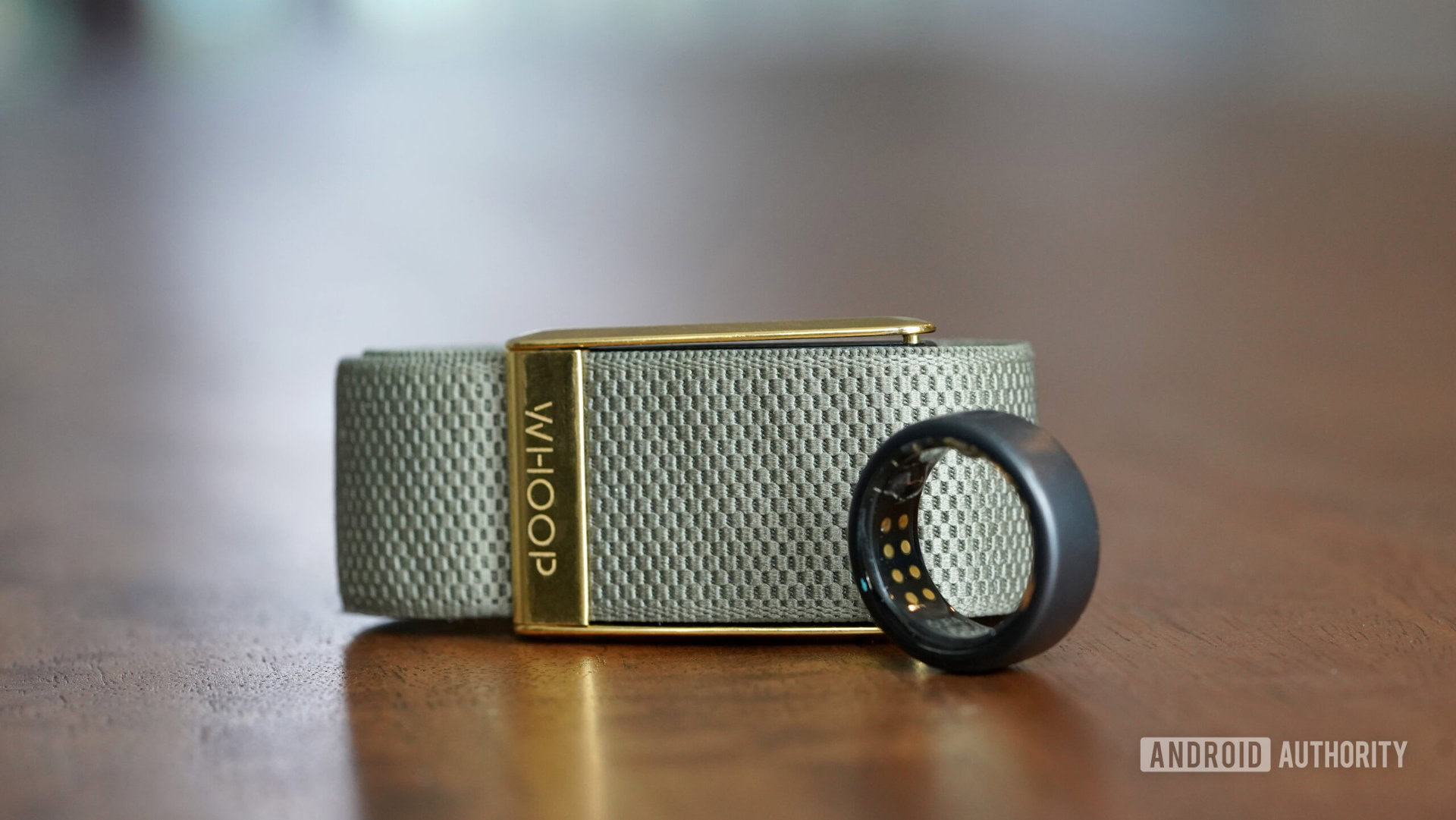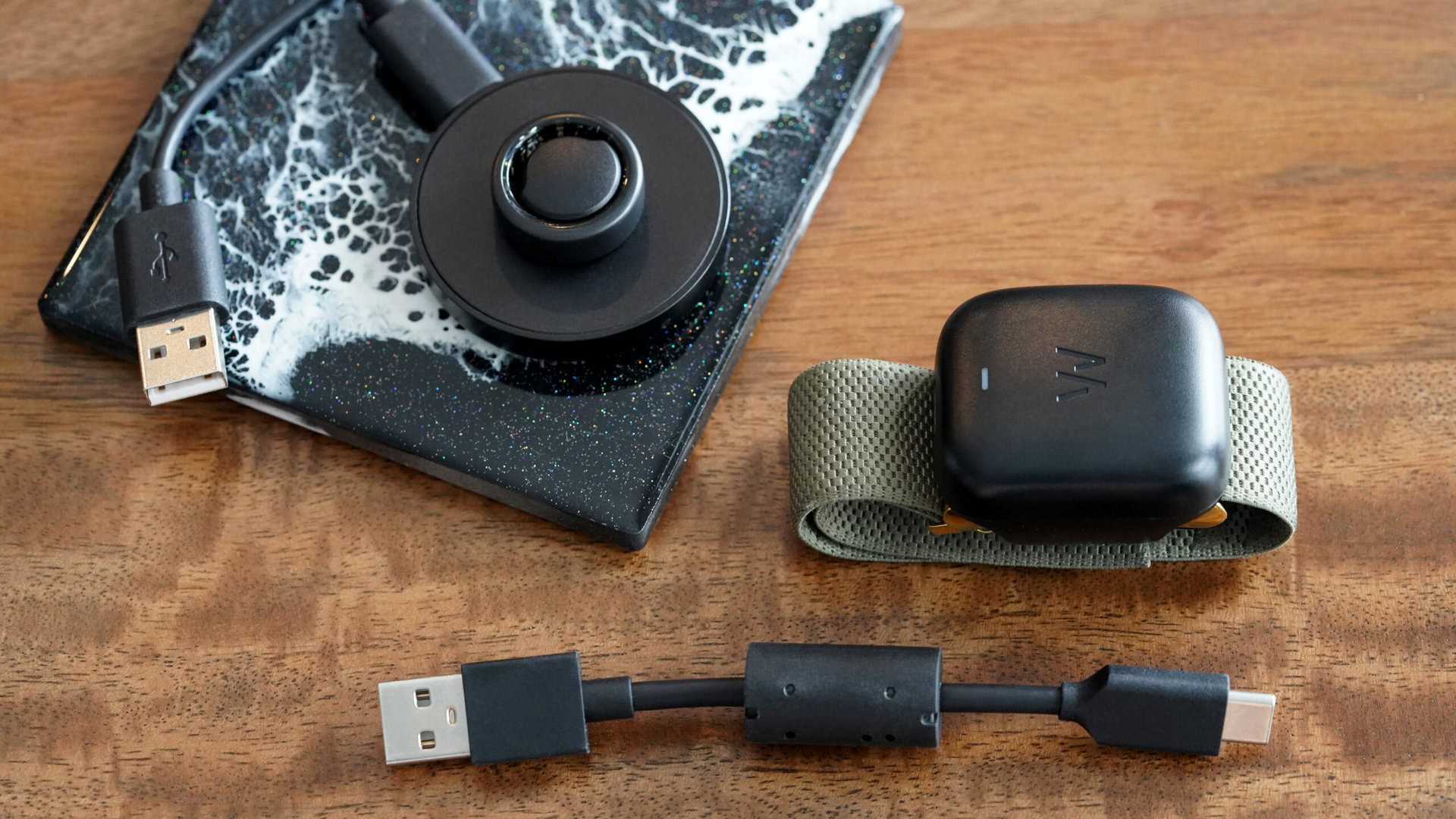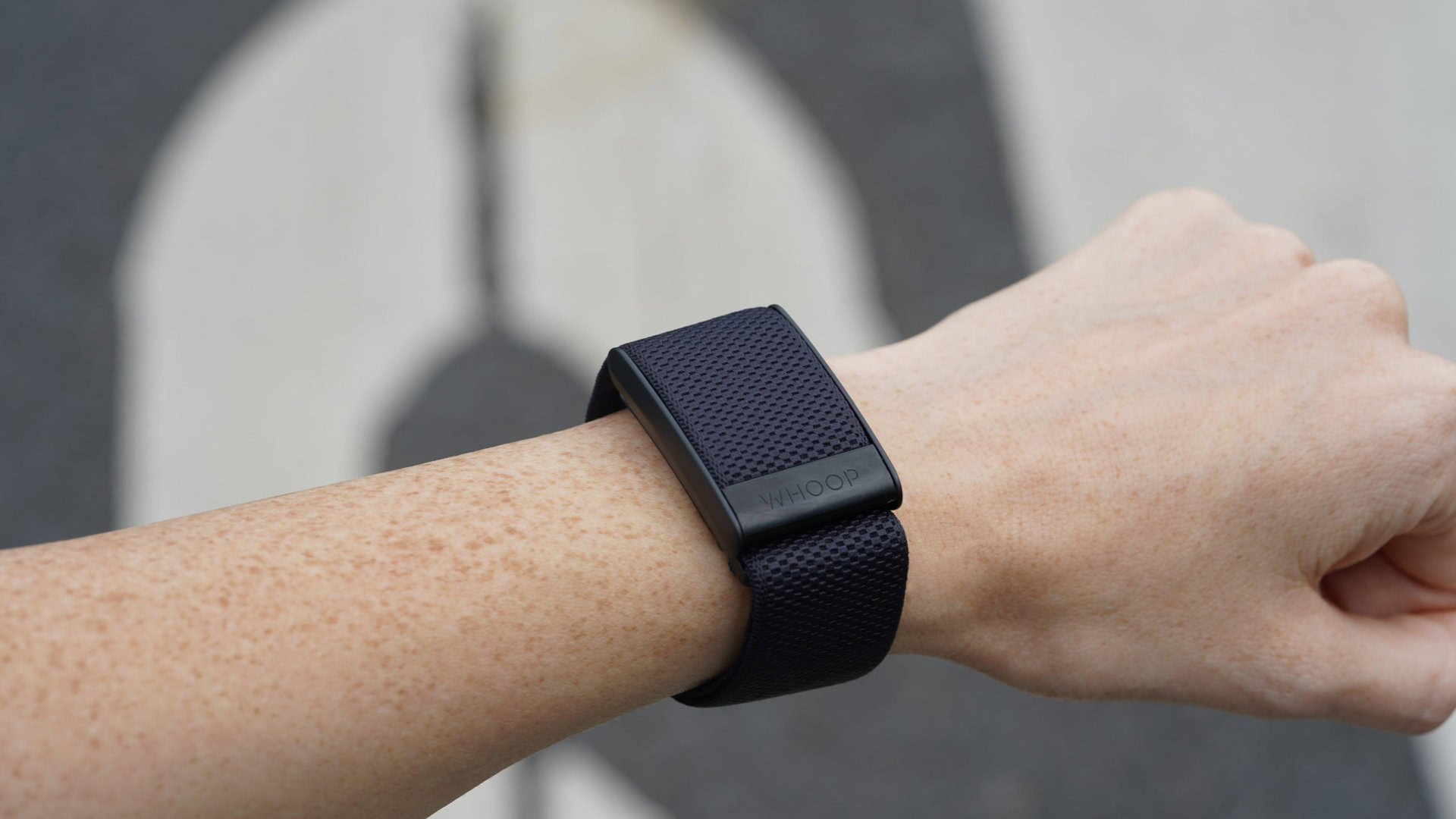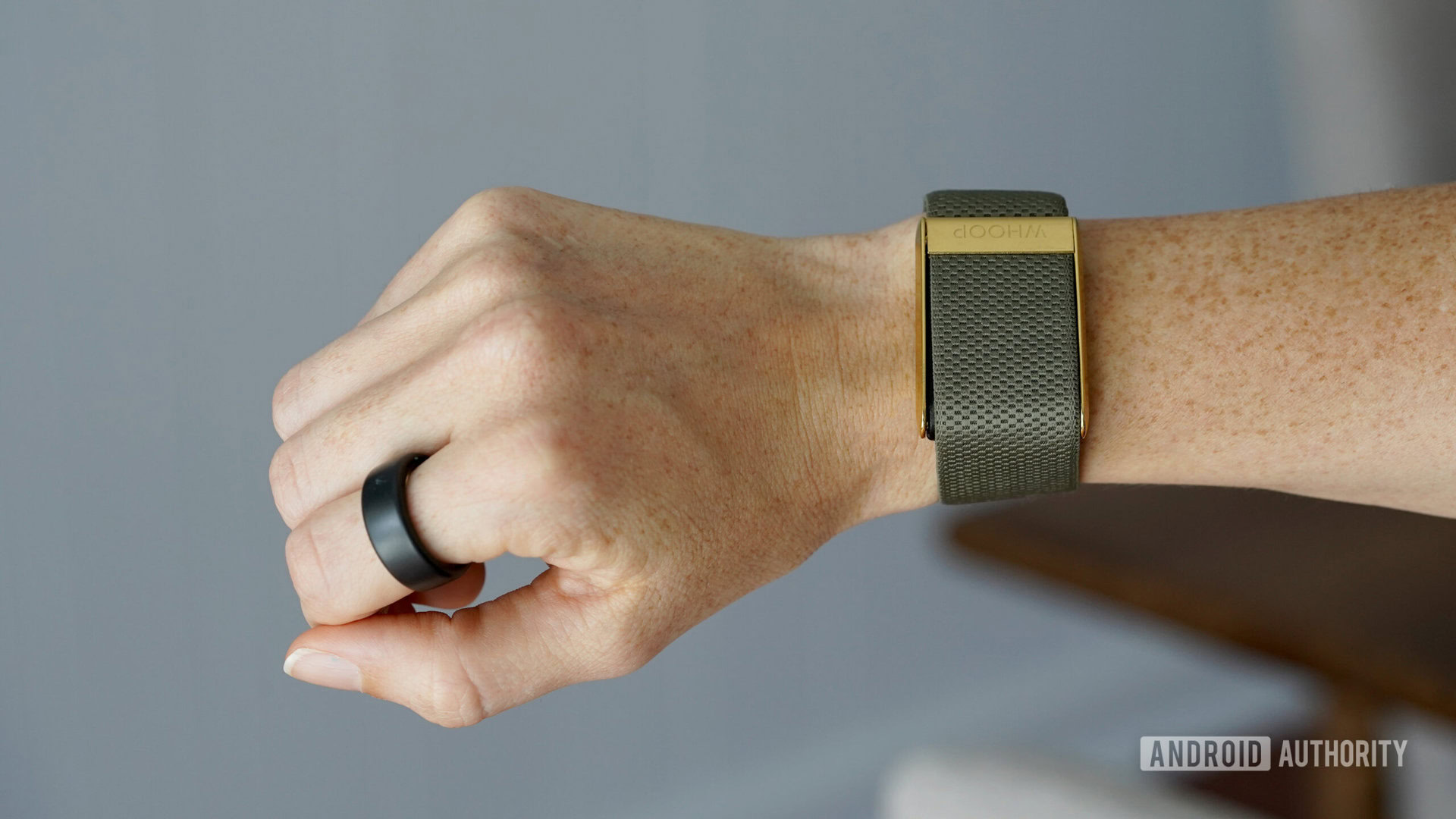Affiliate links on Android Authority may earn us a commission. Learn more.
Oura Ring vs Whoop: A faceless fitness tracker face off

In a market full of flashing screens, animation, and on-device interaction, the Oura Ring and Whoop bands stand apart. Neither ecosystem features a display, but both pack a lot of tools into a wearable device. To find out which of these fitness trackers is right for you, we compare Oura Ring vs Whoop in specs, features, and more.
Oura Ring vs Whoop
Design
The most obvious similarity between Whoop bands and Oura Rings is their lack of a display. This allows for minimalist accessories that blend into users’ day-to-day without calling attention to their tracking goals. They’re also both carefully designed with jewelry cues to ensure an elegant impression. More importantly, neither will distract you during a meeting with alerts and prompts, or wake you by lighting up a dark room. On the other hand, neither offers notifications, real-time workout metrics, or even the current time.
The first prominent difference between the devices is that one is primarily a wristband while the other is a ring for your finger. Whoop bands consist of roughly 7-inch tracker pods and comfortable knit bands with metallic clasps. The most recent model, the Whoop 4.0 is available in black with a huge range of adjustable bands. The newest Oura Ring 3 comes in two styles and 5 colors, each of which is available in 6 different sizes.
Both Oura and Whoop offer elevated, minimalist designs that blend into users' day-to-day, tracking key metrics in the background.
On your finger, the 8mm wide Oura Ring 3 looks like a thick wedding band. It’s chunky for sure, but also lightweight at just 5g. With a useful sizing kit delivered after you order your ring, you can easily find the right option for the most comfortable fit. On the inside, the ring also packs more health sensors than you might imagine fitting into such a tiny space, plus a battery and a Bluetooth chip to pair the device to your smartphone. During our Oura Ring 3 review, we found the ring comfortable for all-day wear, though, after a few weeks, it’s prone to scratches. It’s also not very comfortable for weight lifting or pull-ups.
The Whoop 4.0 also offers a petite, lightweight tracker that’s even 33% smaller than its predecessor. Its metal clasps and bands are interchangeable so you can mix up your look as often as you want. During our Whoop 4.0 review, we were pleasantly surprised by how often we swapped bands to match outfits or activities and found the Luxe options especially attractive. More importantly, we found the device to be easily one of the most comfortable wrist-based wearables we’ve tested. Plus, if you want to take the tracker beyond your wrist, Whoop sells a compatible apparel line including sports bras, leggings, shorts, boxers, and compression tops with built-in slots for carrying your device.
Battery life

Without screens or GPS, both devices offer convenient battery specs. The Oura Ring 3 claims seven days between charges. It also only takes about 80 minutes to charge from 0 to 100%. If you can find a 20-minute window to land the device on its charger each day, you should have more than adequate charge indefinitely. Each ring comes with a proprietary charging puck specified to your ring size. It’s an odd-looking charger but it stays flat and neat on a desk and is easy to drop your ring onto as needed.
The WHOOP 4.0, on the other hand, is intended to remain on your wrist, including while charging. Instead of charging the device directly, the band comes with a rechargeable battery pack that clips on top of your device to transfer juice. Once on the tracker, the battery charges the device in a little more than two hours. From 100% charger, the tracker lasts about five days. Our reviewer found it best to charge while working from home on a computer to not risk losing the battery pack, but you can take it on the go or even on a workout as well. It’s even water-resistant to 1m.
Health and fitness

Oura and Whoop both offer a broad amount of useful health and fitness tracking. Each utilizes SpO2, heart rate, and body temperature sensors to collect key daytime health metrics as well as track sleep. However, their areas of focus and how they dispense the data are quite different.
Oura’s approach is to provide users with a holistic view of their health. Sleep, activity, periods, and more are recorded, but Oura doesn’t prioritize workout data or fitness goals as much as overall well-being. Though the device records dozens of metrics, it boils your data down to three personalized scores: readiness, sleep, and activity. These scores are based on your tracker behavior as well as the personal goals you set within the Oura app. Oura may gently prompt you here and there, but there are no rings to close or streak goals to meet. Furthermore, the device continues to adapt to you the longer you wear it, further personalizing your feedback and analyzing your data trends.
The device does a particularly good job tracking sleep including metrics like time spent in REM, light and deep sleep, nighttime movement, resting heart rate, HRV, respiratory rate, and body temperature. Sleep is one of the three scores Oura’s ecosystem emphasizes and the tracking platform is full of useful insights. The Oura Ring 3 also automatically detects naps.
The Whoop 4.0 uses 24-hour heart rate data to organize your stats into two categories: strain and recovery. When, based on your heart rate, the tracker detects that you are exercising, it automatically begins recording a workout and completes the workout when it detects you are finished. Rather than needing to start a workout manual, Whoop encourages you to maintain an active lifestyle and check in after your gym session. Some users, only check their stats each morning. The Whoop app is user-friendly and displays results in an intuitive format. Like on the Oura app, you can dig into further details across the broader focus topics. You can also enable strain coaching as well as sleep coaching.
Whoop offers in-depth sleep analysis which we found largely accurate during our review period. The newest generation band even offers a haptic alarm that will wake you during the optimal sleep cycle. The companion app even hosts a journal feature that allows users to specify what behaviors they want to record and then analyze how those behaviors affect their sleep over time. For example, you can track your coffee consumption or alcohol consumption, gratitude, outdoor time, and many more variables, then analysis how patterns develop in relation to the quality of your sleep.
Price and color options
Compared to other popular fitness trackers, both Oura and Whoop offer pricey investments. However, a comparison of the Oura Ring 3 vs Whoop 4.0 reveals two very different pricing structures as well. The Oura Ring 3 starts at $299 with increases in price based on which model and color you select. The Heritage design features a flat top while the Horizon is perfectly round. Both offer the same internal specs. The rings are available in silver, black, stealth, and gold as well as in Rose Gold in the Horizon design.
Once you nail down your preferred look, you’ll need to keep your wallet open. To access the ring’s full feature set, Oura requires a $5.99 per month membership. You can use the ring without buying in, but you will only have access to basic scores for sleep, activity, and readiness. The fee is necessary to view your full SpO2 and heart rate data, as well as your trends, analysis, and predictions.


Pricing gets a little weirder with the Whoop 4.0 as technically the hardware is completely free. Instead of purchasing the tracker itself, you are required to commit to a 12-month membership. This membership costs $30 per month. You can also lower the monthly price by about $5 by paying up front. $360 might not seem like an unreasonable ask for a powerful tracking experience, but after that first 12 months, the ongoing fee adds up. Essentially, it’s like buying a new, pricey device every single year. That said, whenever WHOOP releases a new generation of hardware during your membership, you can upgrade to the new model for free. Additionally, if you want to purchase an alternative band, options range from $49-$99. A replacement battery pack is also steep at $49.


Oura Ring 3 vs Whoop 4.0: Which should you buy?

As always, different devices are best for different users. Beyond their obvious form factors, the two trackers have a lot of unique features and focus points. We recommend the Oura Ring 3 for anyone who wants a holistic view of their well-being from a set-and-forget device. It’s a fantastic sleep tracker and a helpful tool for keeping overarching tabs on your health.
Equally subtle and comfortable, the Whoop 4.0 is the better fitness companion. Its workout tracking via heart rate data is reliable and highly useful for athletes. The companion app makes important trends and details highly accessible and the built-in coaching options are great for anyone trying to improve their performance or recovery habits. We also really appreciate the sleep journal feature and the long-term data it provides.
All of that being said, neither device comes cheap and both require an ongoing commitment. If your goal is to make a one-time purchase rather than sign up for a monthly fee, you will not be happy with either of these screen-free options.
FAQs
Both devices are water resistant.
You can shower with both wearables, however, Apple warns that steam can be damaging to the device.
No, the Whoop band does not track steps.
While you technically can lift weights wearing an Oura Ring, we’ve found the experience relatively uncomfortable. Additionally, metal weights tend to scratch the ring’s finish.